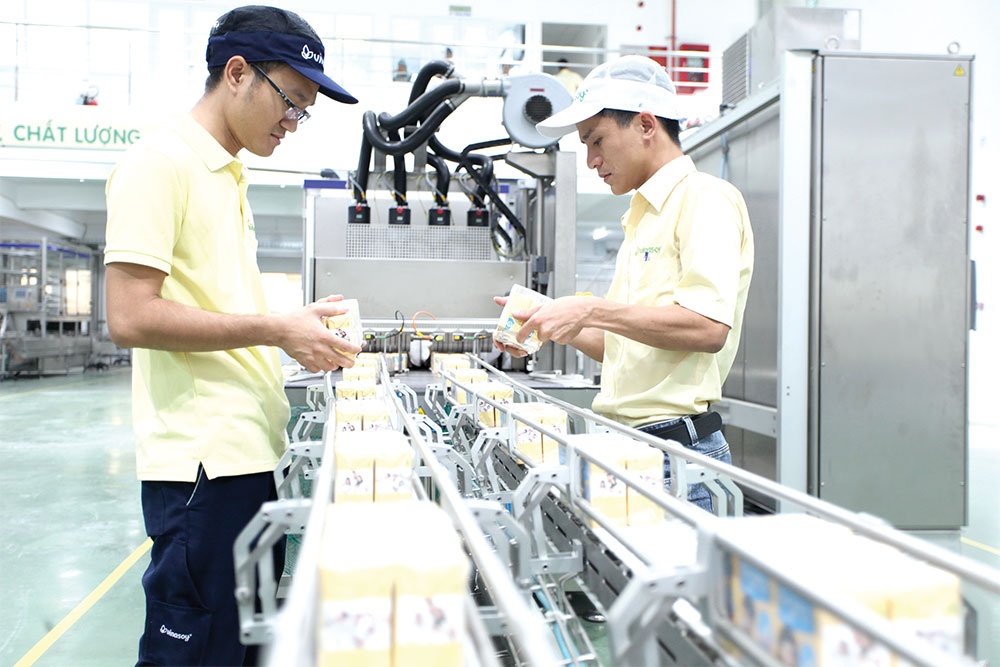Strong macro fundamentals drive outlook for Vietnam
Risks from global inflation have been mitigated by easing global cost pressures, a stable exchange rate, effective price controls, and a steady domestic supply of food.
 |
| Andrew Jeffries - Country director for Vietnam, Asian Development Bank |
Therefore, in an update of its flagship economic report released in mid-September, the Asian Development Bank has maintained its favourable economic outlook for Vietnam as it forecast GDP to expand 6.5 per cent in 2022 and 6.7 per cent in 2023.
Vietnam’s economy recovered faster than expected in the first half of 2022 and continues to grow amid the challenging global economic environment. Growth accelerated by 7.7 per cent in the second quarter and averaged 6.4 per cent over the first half of 2022 – higher than in the same period in 2021 and 2020, but still lower than 6.8 per cent in 2019.
The steady recovery was supported by robust economic fundamentals and driven by a faster-than-expected bounce back of manufacturing and services. Higher input prices constrained industry growth, and manufacturing output moderated due to lower-than-expected demand from advanced economies. The sector contributed 2.3 percentage points to the overall GDP growth rate in the first half of 2022.
Services growth rebounded by 6.6 per cent in the first half from 3.9 per cent in the same period in 2021 on a sharp rise in domestic tourists to about 60.8 million. There were 1.9 times more than in the first half of 2021 and 1.3 times more than the level before the pandemic outbreak.
The rebound in local tourism lifted tourism-related services by 7 per cent in the first half after they contracted by 1 per cent in the same period of last year. The economic recovery boosted growth of banking and financial services, up to 9.5 from 9.1 per cent, and much higher than before the pandemic.
The State Bank of Vietnam has successfully maintained an accommodative but flexible monetary policy to facilitate low-cost financing to help support the economic recovery while containing inflation. It tightened the reins on a rising USD by selling about $7 billion in the first seven months of 2022 to stabilise the exchange rate, keeping the dong’s depreciation against the US dollar at around 2 per cent and leaving the dong more stable than some other currencies in Southeast Asia.
Even as the global economy decelerates, the economic rebound is expected to continue over the second half of 2022, owing to several factors including strong macroeconomic fundamentals, prudent fiscal and monetary policies, and a faster-than-expected recovery in manufacturing, services, and domestic consumption.
Global food shortage and restored global food supply chains will boost Vietnam’s agriculture production this year. However, the agriculture growth forecast is revised down to 3 per cent from the earlier 3.5 per cent projection because high input costs may still constrain the sector’s growth.
Fully normalised domestic mobility and the lifting of pandemic travel restrictions for foreign visitors will support a rebound in tourism in the second half of 2022 that will be stronger than was expected in April, driving services growth up to 6.6 per cent in 2022 but nevertheless below the pre-pandemic growth level of 7.3 per cent in 2019. Weaker global demand should slow Vietnam’s exports.
The VND’s depreciation is making import value more expensive than exports, which is expected to result in a trade deficit in 2022. However, the high degree of integration in global value chains is a structural advantage for the country, which will allow for a fast pick-up in exports once the current global headwinds lessen.
 |
| Increasing inflation in the US and the EU has heightened inflationary pressure in Vietnam, Le Toan |
Vietnam’s fiscal deficit is forecast to widen to 4 per cent of GDP this year on continued price controls, tax cuts, targeted fiscal support, and spending on social security, healthcare, and COVID-19 vaccinations. Sufficient fiscal space, however, is provided by well-controlled public debt, which is estimated at 43 per cent of GDP in 2021, comfortably below the 60 per cent statutory level. National external debt is forecast at 38.4 per cent of GDP, which is within the statutory 45 per cent limit. Despite rising global inflation and interest rates, a strong fiscal position and low public debt have considerably aided Vietnam’s robust economic recovery.
Increasing inflation in the US and the EU has heightened inflationary pressure in the country. However, Vietnam’s prudent monetary policy and effective price controls on gasoline, electricity, food, healthcare, and education should keep inflation in check at 3.8 per cent in 2022 and 4 per cent in 2023.
Rising interest rates by the US Federal Reserve and other central banks around the world could have a significant impact on Asia. However, Vietnam is relatively less affected than other economies in Asia because the country does not have significant government debt in the international bond markets. In addition, Vietnam has a relatively low public debt level, at 43 per cent of GDP, and capital control restricts overseas portfolio investment from rapid inflows and outflows from Vietnam’s stock market.
The Fed’s aggressive monetary tightening is generally associated with higher financial volatility, capital outflows, and currency depreciation in emerging economies. Developing countries in Asia, including Vietnam, will not be immune to spillovers from monetary tightening in the US and other major economies, but we are optimistic that the region is well-placed to weather the consequences.
Over the past few decades, Vietnam has adopted prudent macroeconomic policies including flexible exchange rates to respond to external shocks, effective monetary policy to contain inflation, and measured fiscal policy to keep public debts within reasonable levels. The government needs to maintain an accommodative fiscal policy to support growth, while the monetary space has become narrower due to the necessary monetary tightening to contain inflation.
These policies and measures, along with continuing efforts to strengthen the labour market and accelerate the planned delivery of public investment and social spending, will be critical for Vietnam to grow in the months and years ahead.
| Despite the challenging global environment, the baseline outlook for Vietnam’s economy remains favourable. Reflecting low base effects, GDP is expected to grow by about 7.5 per cent in 2022 and 6.7 per cent in 2023, as growth converges toward its pre-pandemic growth rate of 6.5-7.0 per cent. Despite strong growth, the economy will not return to its full potential in 2022. With the removal of mobility restrictions and the gradual return of foreign tourists, the services sector is experiencing a robust recovery. Growth in manufacturing exports is expected to moderate in the short run as global demand weakens. However, stronger domestic consumption is expected to offset softer external demand, matching the growth patterns of 2016-2019. Inflation is projected to average about 3.8 per cent in 2022, as domestic demand continues to firm up and the rise in transport costs and imported intermediate inputs pass through to the cost of final products. The 2022 consumer price index (CPI) projection assumes further increases in inflation in the second half of 2022. While the fuel price shock is expected to dissipate in 2023, continued second-round effects and a projected 6.7 per cent GDP growth for the year would translate to CPI rising to 4 per cent in 2023 before subsiding to 3.3 per cent in 2024. The rebound of the economy in 2022 will continue to benefit from an accommodative monetary policy and, to a lesser extent, the 2022-2023 economic support programme. In the baseline, accommodative monetary policies will remain in place. On the fiscal side, the investment component of the support programme – amounting to about 1.6 per cent of GDP – is expected to be rolled out mostly from 2023 onwards but is subject to significant implementation risks given the chronic under-execution of capital spending. The current account is expected to register surpluses of 0.2-0.6 per cent of GDP in the medium term thanks to a resilient goods export performance, the recovery of foreign tourism, and strong remittances. Currently, 2023 global prospects are expected to be subdued, with growth projected at around 3 per cent given that high commodity prices and continued monetary tightening are expected to persist into early 2023. But as the commodity price shock dissipates and global inflation and stagflation risks subside, and as China reopens its economy, exports from Vietnam are expected to regain momentum. In the meantime, remittances are expected to remain a substantive contribution to the current account. Source: World Bank |
 | Vietnam picking up slack as hub for chips High-tech investment is making a splash in Vietnam’s economic landscape, and so the country is emerging as the destination for semiconductor manufacturers, where local players are seemingly leading the way. |
 | Vietnam’s supporting industries seeking incentives Vietnamese enterprises are looking for new opportunities amid shifting global supply chains and the volatile world economy, but restrictive policies could be in the way of this endeavour. |
What the stars mean:
★ Poor ★ ★ Promising ★★★ Good ★★★★ Very good ★★★★★ Exceptional
Related Contents
Latest News
More News
- Pivotal stage of growth paves way for rise in M&As (December 03, 2025 | 10:00)
- Positive projections for M&A interest from Thailand (December 03, 2025 | 09:40)
- Manifesting the first line of defence in cybersecurity (December 03, 2025 | 09:00)
- The transformational role AI can play in accounting arena (December 03, 2025 | 08:00)
- Unlocking 5G-AI potential in Singapore (December 03, 2025 | 08:00)
- Data-driven strategies vital for a fast-evolving nation (December 02, 2025 | 09:41)
- Policy to practice: how Vietnam can lead the region (November 26, 2025 | 16:03)
- Mobilising private capital at scale vital for climate battle (November 26, 2025 | 15:36)
- VILAF and Yoon & Yang launch Vietnam - Korea Practice Unit (November 26, 2025 | 15:16)
- Trademark disputes challenge foreign firms in Vietnam (November 24, 2025 | 15:30)

 Tag:
Tag:






















 Mobile Version
Mobile Version